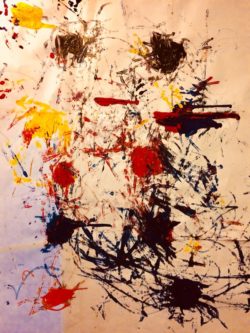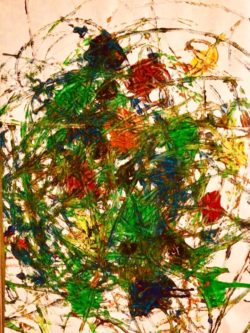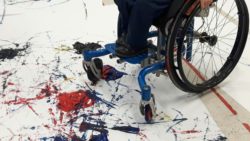Enabling Creativity & Fun for Disabled Children in Malta
Written by Elivira Psaila

Earlier this year our Deputy Director, Angharad Beckett, met with Elivra Psaila, PhD student at the University of Malta, at the inaugural conference run by the Department for Disability Studies, University of Malta. Angharad was delighted to learn of a project Elvira had run to provide disabled children with an opportunity to be creative and have fun. In this blog she describes and reflects upon her experience of implementing a wheelchair painting activity with some of the children with whom she works as a physiotherapist. She argues that what was learnt from this project - that professionals/practitioners must acknowledge the value and power of the child's 'voice' - should inform work with disabled children.
Late last year I attended a public lecture organized by the Department of Disability Studies at the University of Malta. This lecture was entitled 'It's My Right to Play too! Freeing play for disabled children' and it was given by Dr Angharad Beckett (Centre for Disability Studies, Leeds). It focused on the importance of free play in disabled children’s lives. I attended not only because it fell within my remit of study, but also with the hope of picking up some useful tips I could pass on to the parents of children I work with.
Thanks to a short video clip shown by Dr Beckett, I left with an idea for a possible event to be organized by the paediatric physiotherapy department I work in – painting with wheelchairs. This would be an activity where children use their wheelchairs, instead of paintbrushes, to create mural-like paintings.
I saw this as an opportunity to give disabled children a space to express themselves creatively – a refreshing change from their usual sessions with us physiotherapists. An opportunity to use their wheelchairs to get messy and have fun - without worrying whether they have ‘adequate wheelchair management skills’ or if their posture in the chair was ‘perfectly aligned’.
The original idea was to have an extra ‘free’ wheel with different stamps attached to the front of the wheelchair to allow the children to have better control of their design. However, due to the cost of buying and shipping these from the U.S., and not managing to effectively create similar stamps myself with household items, it was decided to use the actual wheelchair tyres themselves as the painting tools.
With a plan in mind, sponsorship for the needed materials and a venue to exhibit the artwork, it was now time to find willing artists. Given that our physiotherapy department provides service to the majority of disabled children in Malta, I assumed that I would easily find children to participate. My colleagues and I identified 5 children who are active wheelchair users under the age of 12. Out of these, 3 could make it on the day – 2 boys ('A' and 'M') and a girl ('E'), aged 5, 11 and 10 respectively.
Finally the day arrived. I was probably more nervous and excited than the children themselves. Would the children enjoy it? How would the parents react?

A's Spiderman-inspired artwork
The floor of our open treatment area was covered with blank white sheets of paper, the bottles of poster paints neatly lined by the sides. A and M, who both have Spina Bifida, arrived first.
A, aged 5, was slightly apprehensive at first. This was quite understandable, given that we physios usually have a habit of turning everything into hard work! I got on my knees and asked him what colours he wanted to use. Blue! And red and black… “I want a Spiderman painting”, he said suddenly. So he told me exactly where he wanted the blobs of paint to go on his area of drawing paper, and he started rolling over the splodges of paint. He started slowly, getting more excited with every push of the chair.

M's painting, a celebration of his favourite colour, green
M, aged 11, knew exactly what he wanted to create. He wanted his painting to be green – his favourite colour. He added some more colours, to keep us adults quiet. And off he rolled. It is also interesting to add that on arriving, M had informed us that he had Fun Day at school so he didn’t want to be with us for long. Half an hour in, and he didn’t want to stop painting – Fun Day at school could wait.
As they painted, I encouraged A and M to roll back and observe how their work was coming along. They then instructed me on where they wanted to add more paint or new colours. When they were satisfied with their artwork, we washed the chairs, took photos, and took the paintings out to dry.

Work in progress

Reflecting - what more is needed to complete this artwork?
Finally it was E's turn. E has cerebral palsy and has speech, language and communication needs, however she signaled which colours she wanted – red, orange and yellow, minimal blue and definitely no black.

E's painting
She also wasn’t too keen on getting her hands dirty, but she smiled as her painting took shape, and as with the boys, we added paint accordingly until she seemed visibly happy with her painting and indicated that she wanted to stop.
And so the artwork was done. The result - 3 distinctive paintings that reflected the artist that created them – a Spiderman themed creation, one that projected green, and a more dainty brightly coloured work. The day was over. 3 children went back to school visibly happy and proud of their work. Before leaving, M made it clear that he wanted to take the painting back home once the exhibit was over. He also asked us for the painting’s dimensions so his mother could pre-order a frame, so his work could hang in the family’s living room. The parents, also seemed extremely proud of their children, and all parents noted that they could easily re-create this activity at home.
So the event seemed to have been a huge success and the paintings would now be enjoyed by the delegates and speakers attending the ‘Emerging Disability Issues – Euro-Mediterranean Conference’ to be held the following fortnight.
But with organizing such an event, comes the responsibility of ensuring that meaningful good has come to disabled children. A discussion with my colleagues (all physiotherapists), who were all present on the day ensued.
It was agreed that perhaps the most obvious observation was how easy it was for the disabled children to take a position of power and instruct me, the professional adult, on what they wanted to be done – the choice of colours and their place on the paper. The disabled children found no difficulty in reversing the expected roles of power – they were in control of their work, they acknowledged this and were not hesitant in ordering me around and telling me, the adult, what needed to be done. This reinforces what is present in current literature. Children, including disabled children, can be assertive and take on a leading role in their life. For this to occur, the adult needs not only to be ready to listen to the child, but also acknowledge, respect and give value to the disabled child’s voice.
Such a position - where the professional adult also acknowledges the value and power of the child’s voice - should transcend the particularity of this painting activity and continue in our daily work with disabled children.
Secondly, this activity made us aware of the very minimal number of young children we work with who are active wheelchair users. The majority of children who would have enjoyed this event, we realized, use K-walkers to walk and still make use of buggies/strollers when tired, or have specialized wheelchairs which are powered by their parents. This, I believe, highlights the idea that having a child, although aged between 3 to 10 years, in a buggy designed for infants is still more socially acceptable (in Malta) than having a child being able to be move around independently in a self-powered wheelchair.
This then leads to the question – are we professionals encouraging and promoting the use of tools and aids that really allow for autonomy and independence even in early childhood? Or is our practice still highly embedded within a medicalized frame of thought – one that still emphasizes the ability to walk as the ultimate definition of independence, and dare I say, the expected ‘norm’?
Do we challenge the parents’ beliefs and expectations, so as to ensure that we are working towards making the child more autonomous, rather than to mould the disabled child into what the parents believe is more socially acceptable?
So upon reflection, an event designed to create an opportunity for fun, was laced with important issues that perhaps were not visible at face value and that need to be explored further. Whilst the children felt empowered, it made us professionals question our everyday practice. And whilst the disabled children’s work was exhibited, it highlighted the need for us adult professionals to step back and acknowledge and respect the voice of the child. Values, that although present in literature and research, still seem to get lost in daily practices that make up disabled children’s lives.
Still, I believe, this event was a success. Not only because of the beautiful work created, as you can see in the photos accompanying this blog post, and the fact that the children themselves enjoyed it. It has led professionals and parents to question their daily practice, and has served as a bridge between the knowledge created through academia and research within the social sciences arena and the everyday reality of a more medical setting. But more importantly, this will lead to similar events to be held later on this year, which will include a larger amount of children. Thus, I hope, more spaces where disabled children are provided with different tools to be able to express themselves creatively and feel empowered and valued will be created.
Author
Elivira Psaila
Visiting Blogger
